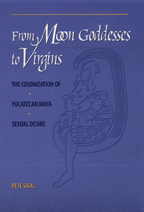Synopsis-- From Moon Goddesses to Virgins
Synopsis
Pete Sigal, From Moon Goddesses To Virgins: The Colonization of Yucatecan Maya Sexual Desire, Austin: The University of Texas Press, 2000.
Pete Sigal’s From Moon Goddesses To Virgins: The Colonization of Yucatecan Maya Sexual Desire is a stunning portrait of the way that the preconquest Maya discourse of desire adapted during the colonial period to create something that was not entirely Mayan, and not entirely Spanish, but something new and truly colonial. Sigal writes, “the Maya ethical system changed into a hybridized form, one in which the two systems (Maya and Spanish) did not replicate either of the prior two” (xiv).
Beginning the project searching for the Moon Goddess, Sigal ended up finding a hybridized Virgin Mary. Sigal writes: “The Virgin Mary Moon Goddess of the colonial Maya people was a virgin, a bisexually active woman, and perhaps a bisexually active man. I look at this sentence and believe that something has gone awry, and indeed something has. The categorizations and boundaries that modern Western peoples prescribe for sexual acts cannot be applied for the colonial Maya … and the Virgin Mary Moon Goddess, rather than embodying a single sexual identity, signified this search for understanding: she symbolized the hybrid sexual discourse of the colonial Maya” (241). This is Sigal’s subject—the creation and performance of a hybrid. Importantly, Sigal deals with shifting mental processes and cultural frameworks, not actual sexual practices at any given time.
This subject is messy, fascinating, and challenging—and Sigal’s analysis of it is excellent. The first chapter introduces the Moon Goddess and the subject matter of the book. We learn that the Moon Goddess was a very powerful goddess, with power paralleling or exceeding that of the other, mostly male gods who were her sexual partners (5). The Moon Goddess represents many things at once. She is the goddess of life and death, the mother, the goddess of sex, and what Sigal terms “The Goddess of Colonialism,” who spread out from Itzá during Maya expansion in the preconquest era (5). Chapter Two lays the groundwork for the cultural similarities between the Maya and the Spanish that allowed for hybridization during the colonial period, when the Maya reinscribed their own meanings onto the gods of the colonizers. Sigal says that the Maya did not classify or categorize sex, and it did not create an identity like a sexual orientation. But they did associate sex and gender with warfare and the political order, and sex had the power to creative normally and destructive in excess.
Chapter Four is titled “Fornicating with Priests, Communicating With Gods,” and it reexamines an anonymous 1774 petition that describes the inappropriate behavior of four secular priests whom the Maya parish wishes to censure in favor of their Franciscan priest, who presented an alternative to the power of the encomenderos. This is significant because it shows the Maya writers’ understanding and use of Spanish gender norms and Spanish clerical celibacy. By the late colonial period, the Maya are using the tools of the colonizers against them (65).
The most fascinating portions of the book deal with the melding of the Moon Goddess with the Virgin Mary in Chapter Five. Preconquest desire for the Moon Goddess transforms into Colonial desire for the Virgin Mary Moon Goddess, who is truly neither but shares attributes of both. After this chapter, there are explorations of the relationships between blood, truth, lineage, and the right of a ruler to rule. Also, the author explains the role of ritual bloodletting of men and women in the maintenance of the community and in the feeding and maintenance of the gods’ pleasure. Very interesting is Sigal’s discussion of the ways that Maya ritual blurred gender boundaries—a daughter might have a penis (171), men might be penetrated (168), and the phallus itself can be understood as a transsexual phenomenon (178). Sigal makes the point that Western Freudian notions of “penis envy” simply do not fit this picture.
Sigal’s use of theory is quite sophisticated. He does not merely throw out a name so that he may put Foucault in the endnotes. Rather, Sigal engages and wrestles with ideas in their contexts—and this includes taking the time to prove that Freudian analysis and the concept of Oedipus does not fit the Mayan context. What is relevant, and critically important to his project, is Sigal’s use of Foucaultian and Lacanian notions of the relationship between power and sex to illuminate his conclusions.
The book, like all books, is not above all criticism. At times Sigal appears gleefully lurid, always using the words “penis,” “vagina,” and “sodomy” where a less textually shocking term such as “genitalia” or “sex act” might suffice. (Which actually is a bit ironic, given the Maya distrust of sexual excess…) One worries that such a hypersexualized and sexually explicit academic volume runs the risk of further “othering” the Maya in the minds of western readers. Additionally, Sigal admits that the Maya language is “extremely complex and metaphorical, consciously veiled” making translation very challenging (xxi). Still, it is clear that Sigal has made a serious effort to translate faithfully, even if translating sexually charged terms from Maya to English is somewhat problematic. It is an exercise in cultural translation, translation from the sixteenth-century to the modern vernacular, and translation between systems that do not always overlap.
Successfully, Sigal delves into a very complicated, seemingly contradictory, and ever-changing discourse of sexuality and makes historical sense out of it. Sigal’s is a groundbreaking work that explores the Spanish Conquest from the perspective of gender. Sigal concludes simply, “Sexual desire never was inert but rather was in a constant state of flux, and it always was used to create a discourse which related to power” (249).

